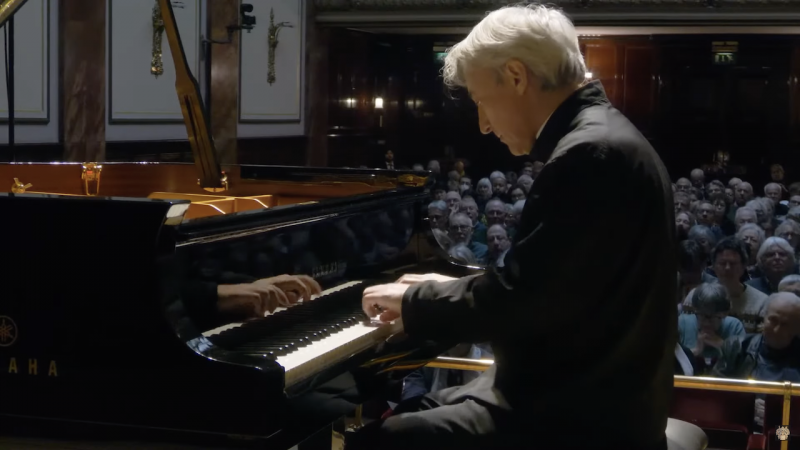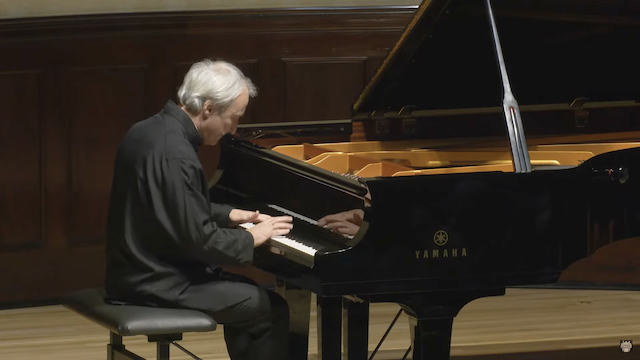Jean-Efflam Bavouzet, Wigmore Hall review - virtuoso brilliance and thoughtfulness reveal Haydn's range | reviews, news & interviews
Jean-Efflam Bavouzet, Wigmore Hall review - virtuoso brilliance and thoughtfulness reveal Haydn's range
Jean-Efflam Bavouzet, Wigmore Hall review - virtuoso brilliance and thoughtfulness reveal Haydn's range
At moments the pianist played as if he were discovering the music for the first time

In a recent interview with the New York Times, Jean-Efflam Bavouzet mischievously described interpreting Haydn’s piano sonatas as “putting clothes on a rather naked skeleton… You have this joy of bringing it to life with all the tools you can imagine.”
Certainly the French pianist is well positioned to talk about exhuming not just Haydn’s music but key aspects of his reputation following his release last year of an acclaimed recording of all 62 of his too often neglected piano sonatas.
For his lunchtime recital at the Wigmore, Bavouzet opened with a version of Haydn’s 1773 Sonata No. 24 in D that glimmered like polished glass in the sunlight. In the taut yet playful opening movement, in which sparky two-part passages alternated with more fluid toccata-style sequences, he deployed the simultaneous virtuosic brilliance and thoughtfulness that would reveal the composer’s startling range.
At first the tone was so light it seemed to defy gravity – quite literally sometimes as his hands flew up into the air at the end of a phrase. But then the shadows crept in as chromatic configurations in the bass introduced more complex harmonies, to which he gave full resonance even as the right hand continued to shimmer.
For the second Adagio movement, in which a lyrical theme plays over a solemn Baroque-style accompaniment, Bavouzet started to give a true sense of how Haydn – as he puts it – “throw[s] arrows into the future.” While he believes these arrows point towards Schumann, Brahms, Prokofiev and even Stravinsky, here the stealthy advance of the left hand and the heartfelt cantabile was most evocative of Beethoven, who would have been just out of nappies when the sonata was written. After the rhythmically nimble Presto movement – interrupted towards the end by a dissonant chord delivered with a defiant smile – we were on to Haydn’s Sonata No. 46 in A flat. This, as Haydn scholar Richard Wigmore explained in the programme, is the sonata most obviously affected by the composer’s almost Damascene conversion after discovering the works of CPE Bach.
After the rhythmically nimble Presto movement – interrupted towards the end by a dissonant chord delivered with a defiant smile – we were on to Haydn’s Sonata No. 46 in A flat. This, as Haydn scholar Richard Wigmore explained in the programme, is the sonata most obviously affected by the composer’s almost Damascene conversion after discovering the works of CPE Bach.
His resulting devotion to the Empfindsamkeit style – which channels a heightened, quasi- Romantic sensibility – is at first on display in the deceptive calm of the opening movement, a movement that Beethoven would echo in his own Opus 110 sonata. Some critics talk about the serenity of this Allegro moderato, yet Bavouzet, rather than being serene, is elegant and lucid, unafraid to exaggerate pauses between musical phrases so we get a full sense of its philosophical reflectiveness.
In the Adagio, composed in D flat major – a key, as Wigmore points out, considered "outré in the 18th century and one never used by Mozart" – Bavouzet achieved a sense of almost prayer-like stillness. Here the lavish ornamentation was no mere flourish, but intrinsic to the depth of expression, expanding the idea of what each musical phrase could be. If there was any criticism of this recital overall, it was in the occasional over-neatness of execution, a brusque if brilliant dispatch of passages clearly performed many times before. Yet here Bavouzet truly played it as if he were discovering it for the first time, slowly unpacking its wonders as an act of revelation for the audience.
In the Finale, Bavouzet was back in polished glass mode, dizzyingly displaying the colours and textures of Haydn’s imagination. The humour and vigour of the performance was emphasised by a triumphant stamp as he dispatched the final chords.
Over the next couple of months Bavouzet will be performing works by composers including Ravel, Bartok and Boulez. Yet there was a point in his career – in 1989 – when the diagnosis of functional dystonia in his right hand made the performance of works with large stretches impossible. This was the moment at which he turned to Haydn, who at that point seemed the only composer he could play without damaging his hands further. The resulting, somewhat mischievous recording of the few Haydn sonatas then in his repertoire, was described by the pianist Zoltan Kocsis as “Haydn without Wig”.
Sviatoslav Richter was one of the musicians whose performances of Haydn persuaded Bavouzet that this interest should be more than a passing fling, not least in what he demonstrated could be achieved by performing the composer’s work on a Yamaha piano. In this recital – for which it was no coincidence that he was also playing on a Yamaha – Bavouzet dazzlingly traced the links between the historic and what he perceives as the more modern aspects of Haydn.
His final piece was Haydn’s 1789 Sonata No. 49 in E flat, written more than two decades after the preceding sonata in the programme. Immediately there was a sense of greater intrigue and urgency, a sense of animated dialogue between the upper and lower registers with the left hand from time to time resonating like a cello. The Adagio cantabile, Wigmore speculates, may have been written as an expression of love for Haydn’s close friend Maria Anna von Genzinger, and in the yearning melodies and greater notational range we certainly sense him discovering a whole new emotional palate. In the Finale there was a relaxation of the tension, though alongside the shimmering light Bavouzet also distilled the sense of compressed heat.
A truly revelatory lunchtime concert then, in which the thrillingly rapid dispatch of Massenet’s Piano Toccata as an encore provided the whirlwind energy to propel us back out into the street. In Bavouzet's masterful interpretation of Haydn we had gained the sense not so much of a journey completed, but of the enduring thrill of the road less travelled.
rating
Explore topics
Share this article
The future of Arts Journalism
You can stop theartsdesk.com closing!
We urgently need financing to survive. Our fundraising drive has thus far raised £49,000 but we need to reach £100,000 or we will be forced to close. Please contribute here: https://gofund.me/c3f6033d
And if you can forward this information to anyone who might assist, we’d be grateful.

Subscribe to theartsdesk.com
Thank you for continuing to read our work on theartsdesk.com. For unlimited access to every article in its entirety, including our archive of more than 15,000 pieces, we're asking for £5 per month or £40 per year. We feel it's a very good deal, and hope you do too.
To take a subscription now simply click here.
And if you're looking for that extra gift for a friend or family member, why not treat them to a theartsdesk.com gift subscription?
more Classical music
 Kanneh-Mason, Britten Sinfonia, Shave, Milton Court - a grin and a big beaming smile
A pair of striking contemporary pieces alongside two old favourites
Kanneh-Mason, Britten Sinfonia, Shave, Milton Court - a grin and a big beaming smile
A pair of striking contemporary pieces alongside two old favourites
 theartsdesk at the New Ross Piano Festival - Finghin Collins’ musical rainbow
From revelatory Bach played with astounding maturity by a 22 year old to four-hand jazz
theartsdesk at the New Ross Piano Festival - Finghin Collins’ musical rainbow
From revelatory Bach played with astounding maturity by a 22 year old to four-hand jazz
 First Person: Manchester Camerata's Head of Artistic Planning Clara Marshall Cawley on questioning the status quo
Five days of free events with all sorts of audiences around Manchester starts tomorrow
First Person: Manchester Camerata's Head of Artistic Planning Clara Marshall Cawley on questioning the status quo
Five days of free events with all sorts of audiences around Manchester starts tomorrow
 Goldscheider, Brother Tree Sound, Kings Place review - music of hope from a young composer
Unusual combination of horn, strings and electronics makes for some intriguing listening
Goldscheider, Brother Tree Sound, Kings Place review - music of hope from a young composer
Unusual combination of horn, strings and electronics makes for some intriguing listening
 theartsdesk Q&A: composer Donghoon Shin on his new concerto for pianist Seong-Jin Cho
Classical music makes its debut at London's K-Music Festival
theartsdesk Q&A: composer Donghoon Shin on his new concerto for pianist Seong-Jin Cho
Classical music makes its debut at London's K-Music Festival
 Helleur-Simcock, Hallé, Wong, Bridgewater Hall, Manchester review - moving lyricism in Elgar’s concerto
Season opener brings lyrical beauty, crisp confidence and a proper Romantic wallow
Helleur-Simcock, Hallé, Wong, Bridgewater Hall, Manchester review - moving lyricism in Elgar’s concerto
Season opener brings lyrical beauty, crisp confidence and a proper Romantic wallow
 Kohout, Spence, Braun, Manchester Camerata, Huth, RNCM, Manchester review - joy, insight, imagination and unanimity
Celebration of the past with stars of the future at the Royal Northern College
Kohout, Spence, Braun, Manchester Camerata, Huth, RNCM, Manchester review - joy, insight, imagination and unanimity
Celebration of the past with stars of the future at the Royal Northern College
 Jansen, LSO, Pappano, Barbican review - profound and bracing emotional workouts
Great soloist, conductor and orchestra take Britten and Shostakovich to the edge
Jansen, LSO, Pappano, Barbican review - profound and bracing emotional workouts
Great soloist, conductor and orchestra take Britten and Shostakovich to the edge
 Jakub Hrůša and Friends in Concert, Royal Opera review - fleshcreep in two uneven halves
Bartók kept short, and a sprawling Dvořák choral ballad done as well as it could be
Jakub Hrůša and Friends in Concert, Royal Opera review - fleshcreep in two uneven halves
Bartók kept short, and a sprawling Dvořák choral ballad done as well as it could be
 Hadelich, BBC Philharmonic, Storgårds, Bridgewater Hall, Manchester review - youth, fate and pain
Prokofiev in the hands of a fine violinist has surely never sounded better
Hadelich, BBC Philharmonic, Storgårds, Bridgewater Hall, Manchester review - youth, fate and pain
Prokofiev in the hands of a fine violinist has surely never sounded better
 Monteverdi Choir, ORR, Heras-Casado, St Martin-in-the-Fields review - flames of joy and sorrow
First-rate soloists, choir and orchestra unite in a blazing Mozart Requiem
Monteverdi Choir, ORR, Heras-Casado, St Martin-in-the-Fields review - flames of joy and sorrow
First-rate soloists, choir and orchestra unite in a blazing Mozart Requiem

Add comment